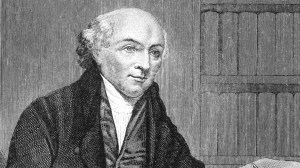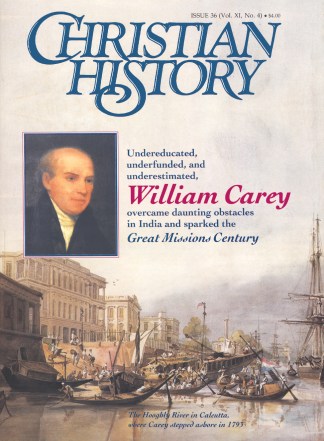In this series

William Carey and fellow missionary John Thomas were riding near Malda, India, in 1794 when they saw “a basket hung in a tree, in which an infant had been exposed; the skull remained, the rest having been devoured by ants.” This “holy” act of infanticide had been committed with religious fervor by a Hindu mother.
Infanticide was not uncommon in India in Carey’s day. But the British government in India ignored such sacrifice of infants—it didn’t want to interfere in religious matters of the people. The Indian masses were ready to sacrifice their lives (and their infants’) for the sake of salvation and to escape the karma-samsara cycle. The people were intensely religious and were following (though sometimes misinterpreting) written religious laws.
William Carey strongly protested these crimes against humanity. He was one of many who prodded the apparently passive government to halt or regulate a variety of harmful social practices.
Killing Infants
In 1802 Carey’s colleague William Ward studied infanticide on the river island of Saugor. Many women made vows to the Holy Ganges River “that if blessed with two children, one would be presented to the River.” As many as 100 children, he estimated (though probably more), were being sacrificed every year.
William Carey, Jr., reported one such sacrifice to his father: A boatman pulled a drowning child into his boat. He presented the infant to its mother. She took the child, broke its neck, and cast it into the river again!
After joining Fort William College as a professor, Carey protested infanticide to Governor-General Wellesley. Wellesley called for a study of the frequency, nature, and causes of infanticide in Bengal. So Carey prepared an exhaustive report; other people were at work as well. Since the attention of the government was now drawn, and Lord Wellesley was convinced, infanticide was abolished in 1802 before Carey even presented his report.
In a letter to John Ryland six years later, Carey explained his contribution: “I have, since I have been here … presented three petitions or representations to Government for the purpose of having the burning of women and other modes of murder abolished, and … in the case of infanticide and voluntary drowning in the river … laws were made to prevent these, which have been successful.”
This marked the first time the British government interfered so directly with religious practice in India. It set the stage for abolition of other practices.
Burning Widows
As scholar E. Daniel Potts explains, widow burning was “based on the religious belief that only by burning could the widow win eternal happiness and bring blessings on her family.” (Sati, or suttee, refers to the act of burning alive a widow on the funeral pyre of her deceased husband; it also names the woman who performs the act.) Voices had been raised against sati for centuries, but no one before Carey had the ability to drown out the voices that encouraged sati.
Carey first witnessed the rite, to his horror, in 1799. (See Burning a Woman to Death in this issue.) The next year, when he saw a group of people assembled for sati, he tried to stop them by (falsely) saying the governor-general had threatened to hang the first man who kindled the funeral pyre!
Carey and other missionaries soon launched a strong protest against sati, saying it was not voluntary but forced. Carey was then asked to submit full information on sati to the governor-general’s council.
In 1803, Carey arranged for a debate of sati at Fort William College. Two years later the governor-general asked the Indian Supreme Court to study how much the practice was based on Hindu law. The report said that sati had a religious sanction, and therefore, any reform would be unwise.
But in 1816, Carey’s former pundit (native teacher), who was now chief pundit of the Supreme Court, determined that sati had no basis in the Hindu Shastras [Hindu sacred writings]. Still sati was debated. Carey’s colleague William Ward and Indian leader Raja Ram Mohan Roy helped influence Parliament to take up the matter in 1821.
Meanwhile, the Baptist missionaries continued their fight. They fired an Indian helper who participated in the sati of his sister-in-law. They continued to write against sati in the periodicals Samachar Darpan and the Friend of India, criticizing the government for inaction.
In 1828, William Bentinck was appointed governor-general. Bentinck, an active Christian influenced by the steady sati debate, had the “stern and unalterable determination … that this atrocious rite should cease absolutely and immediately.” He consulted with Indian leaders and abolished sati in December 1829, which the Serampore missionaries praised as a “bold and decisive step.”
William Carey was the government’s translator into Bengali, and on Sunday morning, December 6, 1829, he received the official declaration that sati had been abolished. He decided that translating the declaration was more important than preparing his sermon. Giving the preaching task to another, Carey raced to translate the declaration by that evening, believing lives hung in the balance every minute he delayed.
Exposing the Sick
The sick and dying often were taken to the banks of the holy rivers and allowed to die. William Ward described such “ghat murders”: “When a person is on the point of death, his relations carry him on his bed, or on a litter, to the Ganges.… A person, in his last agonies, is dragged from his bed and friends, and carried in the coldest or the hottest weather, from whatever distance, to the river side, where he lies, if a poor man, in the open air, day and night, till he expires.” In some cases, the practice veiled simple murder.
William Carey protested against the act in 1802, and later the Serampore journal Friend of India declared that controlling the practice would require “delicate handling, for the strongest religious feelings of the Hindoos” were involved. Yet it was time to halt “barbarous cruelty even in the well meaning.” Till a formal abolition took place, the missionaries occasionally carried home people who were exposed to die and nursed them back to health.
In India’s Cries to British Humanity, Baptist James Peggs brought to the fore the passivity of the government to this “murder.” The Baptist missionaries continuously published against the social evil as well. Finally an otherwise insensitive government was forced to halt such exposures of the sick and dying.
Drowning Lepers
Lepers were rejected by their families and society and sometimes either aided in committing suicide or outright murdered. Carey saw a leper in Katwa in 1812:
“A pit about ten cubits in depth was dug, and a fire placed at the bottom of it. The poor man rolled himself and struggled for that purpose [of getting out of the pit]. His mother and sister, however thrust him in again; and thus a young man, who to all appearances might have survived several years, was cruelly burned to death.
“I find that the practice is not uncommon in these parts. Taught that a violent end purifies the body and ensures transmigration into a healthy new existence, while natural death by disease results in four successive births and a fifth as a leper again, the leper like the even more wretched widow, has always courted suicide.” Others who suffered from what Carey called the “great sickness” were drowned.
The missionaries once again used their vital tool, Friend of India, to make known the lepers’ pathetic state and call for better care. In addition, Carey and Thomas provided medicine, as well as preaching, for many lepers. Missionary wife Ann Grant wrote in 1803, “This morning 34 poor people met before our door … Many with the Leprosy; some with the ends of their fingers, some with their toes eaten off, by the Leprosy, many of them receive two-pence a week. Bro. Carey gives them medicine for their bodies, &the best medicine for their poor souls.”
Protesting Boldly
Carey and his colleagues also objected to slavery (“In some parts of India,” William Ward wrote, “children are as much an article of sale as goats or poultry”). They also spoke out against religious practices involving self-torture and published against the caste system.
One can debate who deserves credit for abolishing the evil practices of infanticide, sati, the slave trade, or the exposure of the sick and the dying. Writers have ascribed the honor to Raja Ram Mohan Roy, Lord Bentinck, and others, as well as Carey.
But Carey definitely raised his voice in protest, and he succeeded in drawing, and keeping, the attention of the government through the publications Friend of India and Samachar Darpan. He and his fellow missionaries stood with the oppressed, reflecting the type of God he believed in—the Friend of India.
Evangeline Anderson-Rajkumar is lecturer in theology and ethics at Serampore College, the institution founded by William Carey, in West Bengal, India.
Copyright © 1992 by the author or Christianity Today/Christian History magazine.Click here for reprint information on Christian History.











